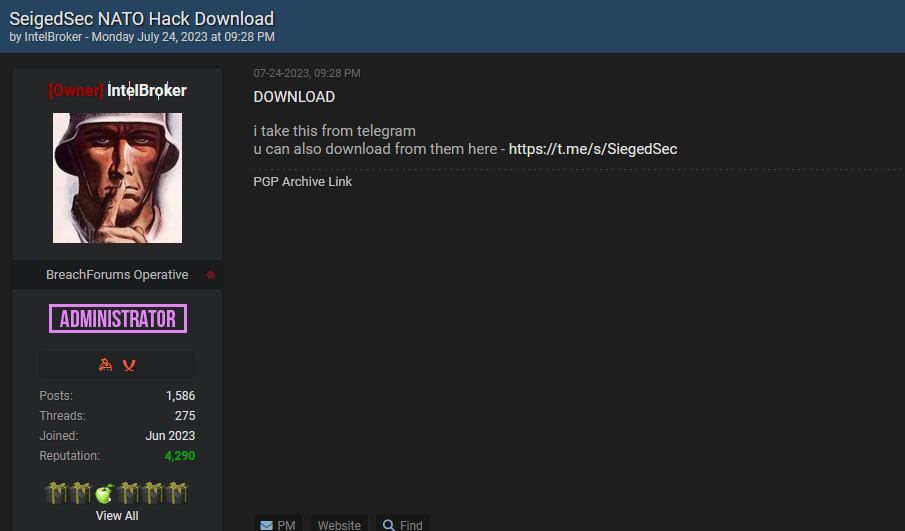SiegedSec Strikes Again: NATO's Sensitive Data Exposed on BreachForums
SiegedSec strikes again! NATO's sensitive data leaked online via Telegram and BreachForums. How safe are our global alliances? Read more on the cyberattack impacting international security! #CyberSecurity #DataBreach #NATO

NATO (North Atlantic Treaty Organization): A military alliance formed in 1949, comprising 31 member countries across North America and Europe. NATO's primary mission is to ensure collective defense and security for its members through political and military means.
🔍 Breach Details
- Date of Breach: July 24, 2023
- Threat Actor: SiegedSec, a known cybercriminal group
- Leak Source: BreachForums post by user "IntelBroker," who appears to be an administrator on the forum
- Content Shared: Links to a Telegram channel and a PGP (Pretty Good Privacy) archive, allegedly containing hacked NATO data
- Distribution Method: Initially shared on Telegram, then disseminated via BreachForums, a well-known platform for trading and sharing breached data
🕵️ Threat Actor Profile
- SiegedSec: A cybercriminal group that has been involved in several high-profile data breaches. Their modus operandi includes targeting large organizations and governmental bodies, then leaking sensitive data to pressure entities or gain notoriety.
- IntelBroker: The administrator of BreachForums who facilitated the distribution of the NATO data leak. This user's involvement suggests an organized effort to share the breached data across multiple platforms.
⚠️ Impact Analysis
- Potential Data Exposure: The specifics of the leaked data remain unclear, but if the information is authentic and sensitive, it could compromise NATO's operations, personnel, and possibly even allied nations.
- Security Risk: Such a leak could lead to a significant security breach within NATO, affecting its operational capabilities and the safety of its personnel. Additionally, it could strain international relations between member countries.
- Public Perception: The leak might erode public trust in NATO's ability to protect sensitive information, potentially affecting its global standing and credibility.
🔐 Prevention Tips
- Strengthen Cyber Defenses: NATO and similar organizations should enhance their cybersecurity protocols, employing advanced encryption methods and regular security audits to identify vulnerabilities.
- Employee Training: Continuous cybersecurity awareness training for all personnel to mitigate the risks of phishing, social engineering, and other cyber threats.
- Incident Response Planning: Regularly updated and rehearsed incident response plans to quickly address breaches, minimizing damage and data loss.




